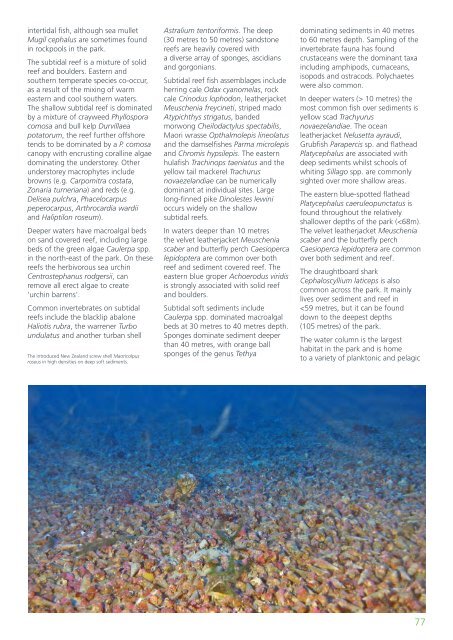Marine Natural Values Study Summary - Parks Victoria
Marine Natural Values Study Summary - Parks Victoria
Marine Natural Values Study Summary - Parks Victoria
Create successful ePaper yourself
Turn your PDF publications into a flip-book with our unique Google optimized e-Paper software.
intertidal fish, although sea mulletMugil cephalus are sometimes foundin rockpools in the park.The subtidal reef is a mixture of solidreef and boulders. Eastern andsouthern temperate species co-occur,as a result of the mixing of warmeastern and cool southern waters.The shallow subtidal reef is dominatedby a mixture of crayweed Phyllosporacomosa and bull kelp Durvillaeapotatorum, the reef further offshoretends to be dominated by a P. comosacanopy with encrusting coralline algaedominating the understorey. Otherunderstorey macrophytes includebrowns (e.g. Carpomitra costata,Zonaria turneriana) and reds (e.g.Delisea pulchra, Phacelocarpuspeperocarpus, Arthrocardia wardiiand Haliptilon roseum).Deeper waters have macroalgal bedson sand covered reef, including largebeds of the green algae Caulerpa spp.in the north-east of the park. On thesereefs the herbivorous sea urchinCentrostephanus rodgersii, canremove all erect algae to create‘urchin barrens’.Common invertebrates on subtidalreefs include the blacklip abaloneHaliotis rubra, the warrener Turboundulatus and another turban shellThe introduced New Zealand screw shell Maoricolpusroseus in high densities on deep soft sediments.Astralium tentoriformis. The deep(30 metres to 50 metres) sandstonereefs are heavily covered witha diverse array of sponges, ascidiansand gorgonians.Subtidal reef fish assemblages includeherring cale Odax cyanomelas, rockcale Crinodus lophodon, leatherjacketMeuschenia freycineti, striped madoAtypichthys strigatus, bandedmorwong Cheilodactylus spectabilis,Maori wrasse Opthalmolepis lineolatusand the damselfishes Parma microlepisand Chromis hypsilepis. The easternhulafish Trachinops taeniatus and theyellow tail mackerel Trachurusnovaezelandiae can be numericallydominant at individual sites. Largelong-finned pike Dinolestes lewinioccurs widely on the shallowsubtidal reefs.In waters deeper than 10 metresthe velvet leatherjacket Meuscheniascaber and butterfly perch Caesiopercalepidoptera are common over bothreef and sediment covered reef. Theeastern blue groper Achoerodus viridisis strongly associated with solid reefand boulders.Subtidal soft sediments includeCaulerpa spp. dominated macroalgalbeds at 30 metres to 40 metres depth.Sponges dominate sediment deeperthan 40 metres, with orange ballsponges of the genus Tethyadominating sediments in 40 metresto 60 metres depth. Sampling of theinvertebrate fauna has foundcrustaceans were the dominant taxaincluding amphipods, cumaceans,isopods and ostracods. Polychaeteswere also common.In deeper waters (> 10 metres) themost common fish over sediments isyellow scad Trachyurusnovaezelandiae. The oceanleatherjacket Nelusetta ayraudi,Grubfish Parapercis sp. and flatheadPlatycephalus are associated withdeep sediments whilst schools ofwhiting Sillago spp. are commonlysighted over more shallow areas.The eastern blue-spotted flatheadPlatycephalus caeruleopunctatus isfound throughout the relativelyshallower depths of the park (
















